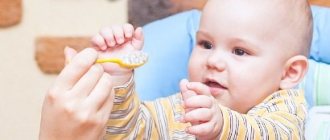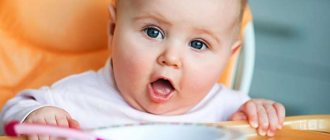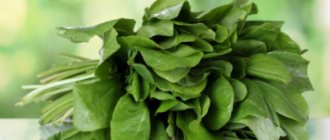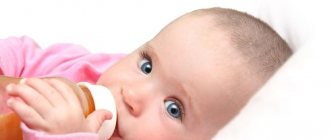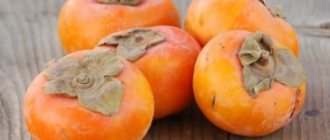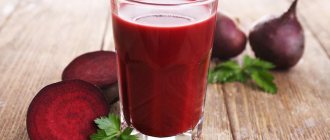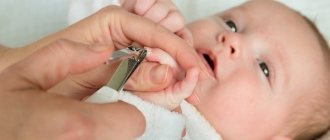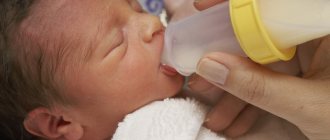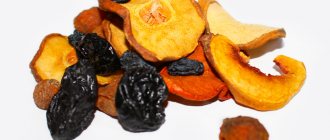Can children eat bread?
Bread is a product made from flour of various grains combined with water, as well as other ingredients - salt, yeast, raising agents, plant seeds, nuts, etc. Bread is produced by baking, steaming or frying. Most often, wheat, rye, corn, barley and buckwheat flour are used to make bread.
It is better not to give bread to children under 1 year of age, as it must be chewed well, and infants often swallow large pieces of food. In addition, it is not an essential food product. Eating bread is more a matter of habit; a person who eats a variety of foods can easily do without it.
Bread can be given to children, but you need to take into account its composition, benefits and harm to the child’s body. First, let's see what types of bread can be bought on our shelves.
RYE BREAD IN A CHILD'S DIET
60-70% of the composition of bread is carbohydrates, which are a source of energy;
10-13% is protein, which is a building material for a child’s growing body.
Bread also contains vitamins:
B1 (necessary for normalizing the process of carbohydrate metabolism and the functioning of the nervous system);
B2 (important for the normal growth of the child);
RR (responsible for the proper functioning of the cardiovascular system and brain function);
E (necessary for proper protein metabolism, proper functioning of the endocrine system).
The most useful substances, complex carbohydrates and fiber are contained in the germ of the grain and in the grain shell of wheat and rye, so it is healthier to eat bread not made from premium flour, but whole grain bread, bread with bran, bread made from rye flour. But the digestive system of children under 2-3 years of age is not yet fully formed, so it should not be loaded with such a product. A child's body is much healthier for white bread with simple carbohydrates, which will quickly saturate it and will not overload the digestive system. In addition, black bread should not be given to children under 3 years of age because it contains oligosaccharides. To digest them, special enzymes are required that are not yet produced by the child’s body.
When can you give black bread to children?
From 7-8 months, you can begin to “introduce” your child to bread, but at this age you can only give him white bread. At this age, you can give about 5 g of white bread per day (the 5th part of a regular piece of brick bread) in the form of a cracker, you can add it to soup. At 1 year, the daily portion can be increased to 10 g, at 1-1.5 years - up to 20-25 g (1 piece), at 1.5 years - up to 50-60 g (2 pieces), at 2 years - up to 60 -80 g (3 pieces).
From the age of 2, instead of white bread, a child can sometimes be given bread with bran.
From the age of 3, children can be given black bread, but not often and not in large quantities. If, with the start of introducing black bread into your child’s diet, anxiety, colic, flatulence, and stool abnormalities appear, then you need to stop eating it and consult your doctor.
According to nutritionists, white bread is the easiest for children under 3 years of age to digest; it is quickly absorbed by the body, but is poor in useful elements. Rye and black bread contains more fiber, a lot of lactic acid bacteria, it is rich in vitamin E, B vitamins, zinc, magnesium, iron, which ensures the proper development and uninterrupted functioning of all organs and systems of the child.
Found an error in the text? Write in the comments, it will certainly be corrected.
Material prepared by:
Founders of the project:
@gotovimdetyam
Zolotova Kristina and
Ragozina Ekaterina
Popular types of bread in Russia
— Rye black bread.
— Borodino bread with caraway seeds (a type of rye bread).
— Gray bread made from rye and wheat flour (the most popular option).
- White bread made from premium or 1st grade wheat flour without additives (the varieties - loaf and bun - differ in the method of preparation, the amount of flour, water and additional additives; the bun has a more concentrated dough).
— Whole grain bread (with bran) with a high content of vitamins and fiber.
— Corn bread.
— Potato bread (rare on store shelves, but it is actively baked at home).
- Yeast-free bread - instead of yeast, special starters are added.
— Baked goods are sweet flour confectionery products (buns, donuts, gingerbreads, pies).
- The Slavic loaf has a sweet taste and splendor - it is used at weddings and when receiving guests.
— Lavash is a flat Armenian bread without yeast.
— Shoti is Georgian bread with the addition of yeast, it is baked in a tandoor, and it has a certain shape. We often call it lavash.
— Pita is a flatbread for wrapping other foods. We often make shawarma or shawarma with it.
Bread baking methods
— in a baking oven (there are options for home ovens);
- in a Russian stove;
- in the tandoor.
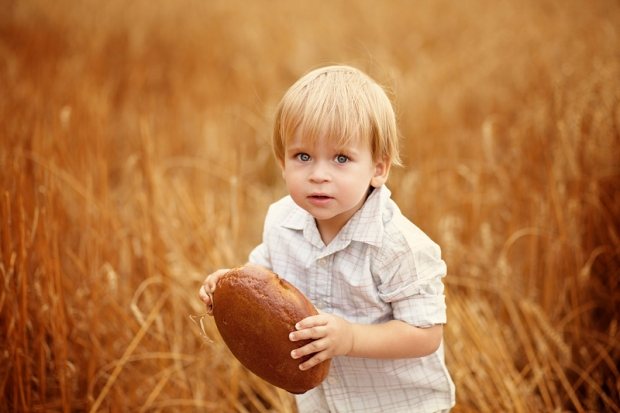
Is bread a healthy food?
Bread contains a huge amount of useful substances. However, there is a very widespread opinion that the benefits of a product made from finely ground flour are very questionable, especially in cases related to the nutrition of children. Is it so?
In their desire to make their baby’s diet more varied, mothers often add foods that a small child’s body is not able to cope with. The main product that is mistakenly introduced to young children is bread. Is bread a healthy food?
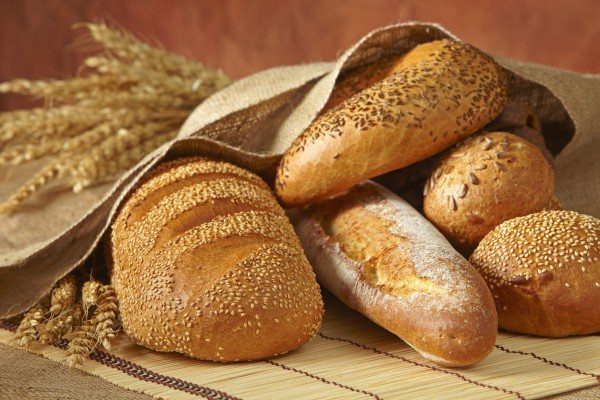
The answer here is ambiguous. If bread is made using the correct technology and from high quality raw materials, then it will certainly be very useful, because it contains:
- iron;
- vitamins of group B and PP;
- phosphorus;
- magnesium;
- calcium;
Additionally, it contains large amounts of fiber, which helps improve metabolism and the functioning of the gastrointestinal tract as a whole. But this does not mean at all that bread should be given to the baby.
Manufacturers sometimes add excessive amounts of baking powder and thermal yeast, which only worsens human health. Therefore, it is preferable to bake it yourself at home.
Still, you should not give bread to a small child, even if it is of high quality. Pediatricians believe that infants do not need to be given fresh white and rye bread at all, even in the form of crackers.
Due to the presence of a considerable amount of gluten and polysaccharides, the product will not be very useful for the baby. These substances are difficult for an adult to digest, but they can cause very serious harm to the body of such a small child.
Bread also contains gluten, to which children may have an allergic reaction.
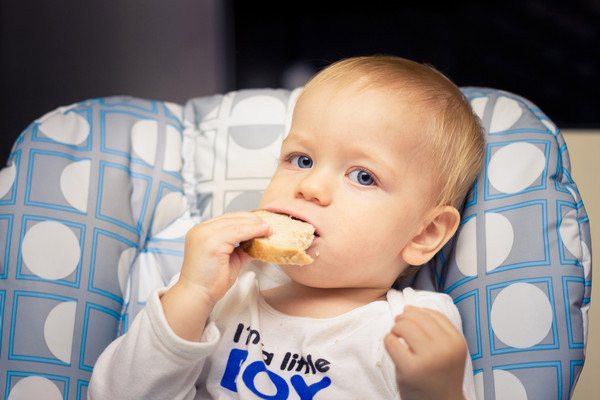
The benefits and harms of bread for a child
Any bread contains a large amount of proteins and carbohydrates. Bread is considered a fairly high-calorie product, and the better the type of flour, the more carbohydrates and less fiber and vitamins it contains.
All types of bread contain B vitamins, which are beneficial for child development.
It is healthier for adults to eat rye or wheat bread with bran. For children, bran is difficult to digest and assimilate, so bread with bran can be given to a child only after 3 years.
White bread is very tasty and soft, but rolls and loaves made from premium flour are not good for a child’s health; they can cause tooth decay and excess weight gain.
Bread must be chewed well, otherwise it will be poorly digested, which is why it is not given to children under one year of age.
Rye bread can cause increased acidity in the gastrointestinal tract.
Yeast baked goods can cause increased fermentation, gas formation, and stool upset in a child.
Yeast-free bread is best digested and does not cause stomach discomfort; it is preferable to start introducing bread to a child with it.
Pay attention to the composition of the bread; it may contain eggs, leavening agents, yeast, flavorings and other food additives that can lead to allergies or digestive problems.
Let's look in more detail at the chemical composition of different types of bread in 100 grams of product to understand their nutritional value.

How to give bread to a child so he doesn't choke
This question interests many mothers. I also encountered this problem. I decided it like this. For the first feeding, I soaked the pulp in breast milk. The bread came out in the form of a mush. And it was not difficult for the child to chew it.
Some experts advise giving your baby a stalk of celery first. It will develop a chewing reflex in the baby, without the risk that the baby will be able to bite off or swallow it. And only then offer him some bread.
Well, what else remains is to start giving the child the crust, not the crumb. He will suck it the first time. But mommy will need to be nearby and make sure that she intercepts the bread in time when it is already close to biting off.
Well, in any case, until the baby himself learns to chew and swallow correctly, you will have to constantly be near him during meals. But don't worry, your baby is capable, and this chewing skill will come to him quickly enough, so don't worry.
Chemical composition of different types of bread (table)
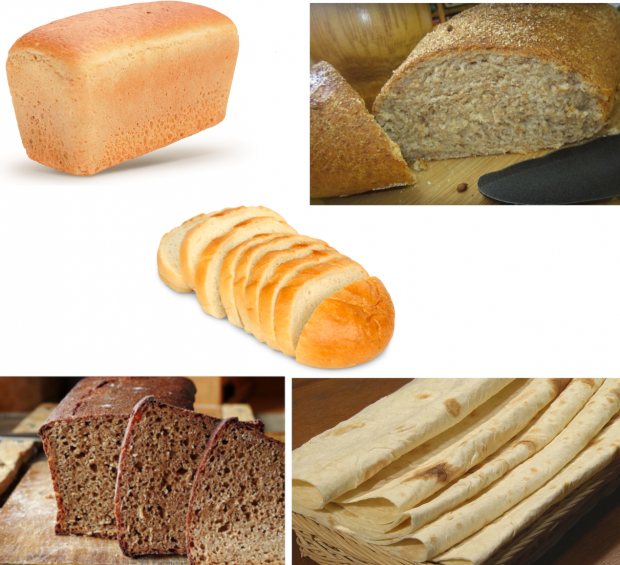
| Index | Wheat white bread | Wheat with bran | Black rye bread | Sliced loaf | Pita |
| Water, g | 37,8 | 37,7 | 47 | 34 | 32,1 |
| Fats, g | 0,8 | 3,4 | 1,2 | 2,9 | 1,2 |
| Carbohydrates, g | 49 | 47,8 | 33,4 | 51,4 | 55,7 |
| Dietary fiber, g | 2,7 | 4,0 | 8,3 | 2,5 | 2,2 |
| Proteins, mg | 7,6 | 8,8 | 6,6 | 7,5 | 9,1 |
| Vitamin A, mcg | — | — | 1,0 | — | — |
| Beta-carotene, mg | — | — | 0,006 | 0,01 | — |
| Vitamin E, mg | 1,1 | 0,32 | 1,4 | 1,7 | 0,3 |
| Vitamin B1 (thiamine), mg | 0,11 | 0,4 | 0,18 | 0,1 | 0,6 |
| Vitamin B2 (riboflavin), mg | 0,03 | 0,3 | 0,08 | 0,03 | 0,3 |
| Choline, mg | 37,8 | 18,7 | 60 | 53 | 14,6 |
| Biotin, mcg | 1,24 | 1,20 | 1,8 | 1,7 | 1,84 |
| Vitamin B5 (pantothenic acid), mg | 0,19 | 0,54 | 0,6 | 0,3 | 0,4 |
| Vitamin B6 (pyridoxine), mg | 0,087 | 0,18 | 0,17 | 0,15 | 0,03 |
| Vitamin B9 (folic acid), mcg | 22,5 | 161 | 30 | 28 | 165 |
| Vitamin PP, mg | 3,1 | 4,4 | 2,7 | 3,0 | 4,6 |
| Vitamin K, mcg | — | 1,3 | — | — | 0,2 |
| Lutein, mcg | — | 54 | — | — | — |
| Calcium, mg | 20 | 74 | 35 | 19 | 86 |
| Iron, mg | 1,1 | 3,1 | 3,9 | 1,2 | 2,6 |
| Magnesium, mg | 14 | 82 | 47 | 13 | 26 |
| Sodium, mg | 491 | 486 | 610 | 427 | 536 |
| Potassium, mg | 93 | 227 | 245 | 92 | 120 |
| Copper, µg | 80 | 221 | 220 | 135 | 169 |
| Selenium, mcg | 6 | 31 | 5 | — | 27,1 |
| Fluorine, mcg | 14,5 | — | 35 | — | — |
| Chromium, µg | 1,6 | — | 2,7 | 2,2 | — |
| Zinc, mg | 0,526 | 1,4 | 1,2 | 0,74 | 0,84 |
| Molybdenum, mcg | 10,6 | — | 8,0 | 13,6 | — |
| Manganese, mg | 0,45 | 1,7 | 1,6 | 0,837 | 0,5 |
| Iodine, mcg | 3,2 | — | 5,6 | — | — |
| Phosphorus, mg | 65 | 185 | 158 | 65 | 97 |
| Calorie content, kcal | 235 | 248 | 174 | 262 | 275 |
As we can see from the table, the healthiest is wheat bread with bran, since it contains the most vitamins and minerals. In addition, it contains essential amino acids and fatty acids Omega-3 (0.035 g) and from 0.9 to 3.7 g and Omega-6 (0.614 g).
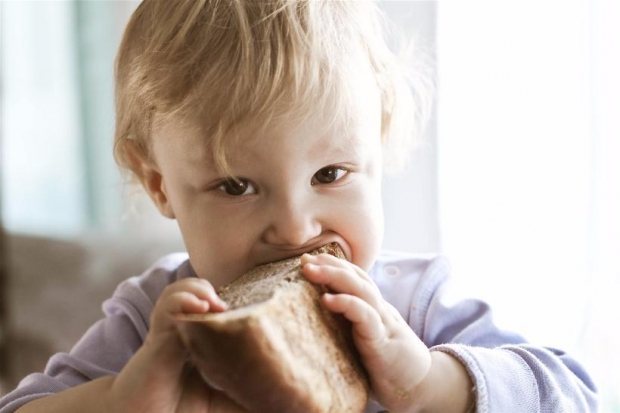
What kind of bread can be given to a child and when?
It is difficult to imagine the diet of a modern person without traditional bread products. Taking into account the importance of this component, parents are often interested in when it is best to introduce bread into the baby’s diet, in what form it should be, and what dosages should be followed.
Experts have long compiled detailed instructions answering all of the above questions. If you follow its recommendations, you can count on receiving benefits from the components of the food product and minimal risk of developing negative consequences for the developing organism. An allergy that threatens a child due to the presence of certain additives in the mixture will again not manifest itself.
The benefits of baked goods for a growing body
Some mothers, prone to causeless panic and playing it safe on every issue, try not to give their baby bread at all until he is a year old or even more. According to pediatricians, this is a big mistake, because bread contains so many useful components that any other food component of the diet will envy.
- All types of black, cereal and bran bread contain an impressive amount of fiber and lactic acid bacteria. These components help stimulate the activity of the digestive system.
- White bread is very easily accepted by the child's body. Despite the fact that it is not as rich in beneficial elements as other varieties, it is recommended to be given to children when they experience frequent digestive upsets.
Tip: When buying bread for a child, you should choose only those products whose composition can be read on the label. Despite the rapid growth in popularity of small bakeries producing delicious and fresh baked goods, you should not offer them to babies (unless you have the opportunity to familiarize yourself with the recipe described in the quality certificate). Such products often contain additives that are safe for adults, but to which an infant may be allergic.
- High-quality bread products are rich in vitamin E, magnesium and iron. For this reason, nutritionists recommend giving black bread to overweight babies.
- Even the texture of the product is beneficial for a newborn baby. It forces the baby to chew food, developing the jaw apparatus and cleansing the oral cavity of pathogenic bacteria. When the product, broken down into fibers, then passes through the digestive tract, it helps to collect and remove harmful breakdown products from the body.
- B vitamins, especially B1, are necessary for the normal functioning of the nervous system and the launch of metabolic processes that promote the breakdown of carbohydrates. A deficiency of this component manifests itself in a child as weakness, irritability, fatigue and drowsiness.
- Vitamin B2 promotes growth processes. Without it, the condition of the baby's mucous membranes, skin and hair rapidly deteriorates.
In addition to all of the above, we must not forget that aromatic and tasty bread promotes the secretion of gastric juice, which starts the digestion process. Thanks to this, bread can be used as an irritant when feeding children with poor appetite.
At what stage what kind of bread is right to give to a child?
Receiving benefits from bread is guaranteed only if you know when and what types of product to give to your baby, in what volume and with what frequency. Otherwise, you can provoke the development of dyspeptic disorders in the child. A little less often, when the product is incorrectly introduced into the diet, an allergy occurs, but if it comes to this, the baby will have to do without the therapeutic properties of bread for several months.
Experts recommend adhering to the following action plan:
- For a seven-month-old baby, you can start giving baby cookies or special crackers without additives.
- We introduce bread in its pure form from white varieties of wheat into the menu at 8 months. Acquaintance begins with 3 g, by the year, gradually increasing the serving size, we bring the daily norm to 20 g. Do not worry if this amount seems too large for the baby, and he cannot cope even with this volume. Even a small amount of the product is sufficient to obtain therapeutic benefits.
- Such healthy varieties of rye bread and bran composition can be given to children no earlier than 2 years old, unless there are specific recommendations from a pediatrician. In children at an earlier age, enzymes simply may not be able to cope with such complex foods, resulting in allergies.
- There is no need to offer salt-free bread to the baby if there are no appropriate indications for this (kidney or heart problems).
Important!
Nutritionists are shocked! You can easily LOSE WEIGHT after giving birth! A cheap and effective remedy, after taking it, excess weight will disappear forever... Read more » With the spread of bread machines and the emergence of housewives with the opportunity to bake bread themselves, the question arose whether such a product could be given to infants. The approach has both advantages and disadvantages:
- If your child is allergic to a store-bought product, you should really try to prepare a homemade version, eliminating the provoking components from it.
- Children under 2 years of age are strictly prohibited from eating fresh bread, especially fresh from the oven. The finished product should cool and sit for several hours.
- At home, baked goods often turn out not fully fried; this is also unacceptable for a child’s body. To check the quality of the bread, you need to squeeze it. If he quickly regains his shape, everything is fine. If it remains flattened, it is still raw inside.
If you follow all of the above points, you don’t have to worry about the health of the child who tried the bread. The main thing is to monitor its condition and respond to any changes in a timely manner.
We advise you to read the article about what kind of fish you can give to your child
The most beloved and long-awaited child was born, and with him EXCESS WEIGHT. But caring for a child does not leave time for oneself or for the gym. And most diets can have dangerous consequences for both mother and baby.
But I really want to put on my favorite dress, heels again and look great as before... There is a way out - stories from moms about how easy it is to lose 20+ KILO!
Read more "
TheRebenok.ru
What kind of bread can a child eat?
For the first acquaintance with bread, it is best to use children's cookies. Such cookies are allowed to be used from 6 months, but in practice they should be given no earlier than porridge, that is, after 8 months. The first time it is soaked and given to the baby. Then, over time, you can give the child the whole cookie, as it dissolves under the influence of saliva.
Among ordinary baked goods, for the first acquaintance, high-grade wheat bread without yeast is suitable, as it is very soft and airy. The bread crumb should be soaked in the soup. Then you can gradually introduce the child to other types of bread: gray, black. It is best to prepare the bread yourself in a special stove or oven, then you will know exactly what is included in it.
What kind of bread can be given to children?
First of all, this is bread baked from first-class wheat flour. Ideally, you should bake it yourself at home. Only in this case can you be completely confident in the quality of the product and that it does not contain harmful impurities.
If this is not possible, and you have to buy bread in the supermarket, then you need to pay attention to its freshness and integrity. In addition, it is important that the product does not have dents or burnt areas. It is not recommended to buy loaves of bread for a small child; it is better to give preference to the usual “brick”.
At what age can you give your child bread? For babies who have not yet turned one year old, select only high-quality wheat products, then you can gradually introduce rye products. You can try bread with bran no earlier than two or three years, since grains are poorly digested in the bodies of young children and can disrupt digestion.
Important! Under no circumstances should children be given freshly baked products! They contain a lot of gluten, which can disrupt the functioning of the digestive system.
It is equally important to know how to give bread to your child. For the first complementary feeding, the product should be softened by soaking it in mother's milk or formula. This point must be observed, since small children still do not have a chewing reflex, and they may choke.
How to give bread to a child
Bread is given to the child with the main dish (soup, porridge, vegetables). The amount of bread you give your child should be small - 1 slice of bread or 1 cracker, or 2 cookies per day. Details of how much bread to give a child in grams daily are presented in the table.
| Age | Quantity per day |
| from 1 to 3 years | 50-80 g |
| from 3 to 7 years | 80-120 g |
| from 7 to 12 years | 100-140 g |
| from 12 and older | 140-200 g |
When can you give bread to a child?
Some mothers can’t wait to give bread to their child as soon as possible. They are trying to soak it and add crumbs to the diet.
But bread and regular cookies may contain eggs, yeast, fillers, leavening agents, and flavorings. Gastrointestinal irritation, increased gas formation, stool disorders, both diarrhea and constipation can cause allergies in children. Therefore, up to 1 year, it is better to limit yourself to baby cookies.
Crackers, regular cookies, bread crumbs can be given to a child from 1 year of age to try, after soaking them in some liquid. Add bread crumb to soup, soak crackers or cookies in tea. If you decide to give your child bread for the first time, it is better to start with wheat, the highest grade, it has a more delicate structure. And only when the child gets used to it, try rye bread.
The amount of bread in the diet should be small: 1 cracker or 1-2 cookies or 1 slice of bread per day.
A child can be given bread as a snack to the main dish, just like an adult, when he learns to chew well from one and a half to two years.
Children's cookies
Baby cookies are a special treat for infants; manufacturers write that they can be given from 5-6 months, but in fact they are given after porridge and juices from about 8-9 months, depending on the timing of the introduction of the first complementary foods. It dissolves well in food or baby saliva and does not need to be chewed.
Cookies for children under 1 year of age should not contain eggs, but only flour, water, sugar, milk, vegetable oils and fruit additives. As a rule, children's cookies are enriched with additional vitamins.
But you should not overuse it, as it is very high in calories and can contribute to obesity and tooth decay. You can do without it if the child eats baby cereals, vegetables and fruits well.
Children's cookies are not recommended for a child's daily diet; a child can eat them no more than 2-3 times a week, 50 g per day.
Children's cookies are made by the following manufacturers: Hipp, Heinz, Samper, Begemotik Bondi, Baby, Chipa and others.
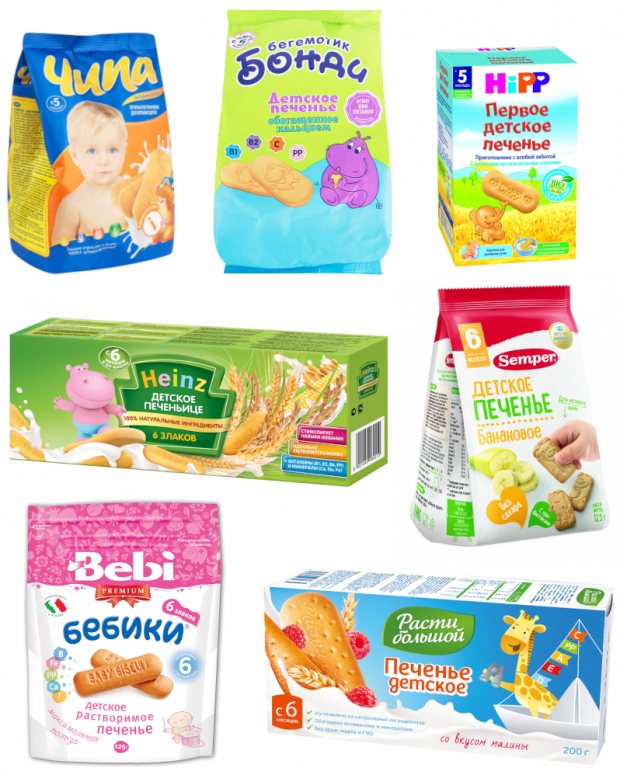
At what age and what kind of bread should I give my child?
About half of bread is carbohydrates
, which are represented predominantly by starch. Bread made from rye flour contains a high content of substances such as oligosaccharides, which the child’s body is not able to digest and utilize due to the lack of enzymes necessary for this.
Thanks to the aroma of bread, digestive juices are released in the body
, which helps improve digestion and absorption of food. Starting from , pediatricians recommend adding crackers and baby cookies to your child’s diet. If the child cannot chew yet, then you can dissolve the crackers in milk. Bread can be given starting from about 3 grams per day. By one year this norm is increased to 20 grams, by three years – to 80 grams. Rye and freshly baked bread are not recommended to be included in the diet.
For children from 1.5 years old, various drying products, crackers, bagels are recommended
. When choosing these products, you should pay attention to the content of various additives that can cause an allergic reaction. If you have such an item as a sandwich maker, then you yourself, without making any extra effort, can prepare bread products that do not contain additives that are dangerous to the child’s body. There are sandwich makers with various attachments in the shape of, for example, animals, or some fairy-tale characters. Such bread will undoubtedly be interesting for a child.
It is better to refrain from eating confectionery products, cookies, gingerbreads, and buns.
. As is known, the consumption of these products contributes to obesity, including in children. A person's appearance in adulthood depends on nutrition in childhood. Foods that crumble easily, such as excessively dry foods, should not be given to a child who has not yet learned to chew well, because he or she may choke on them.
